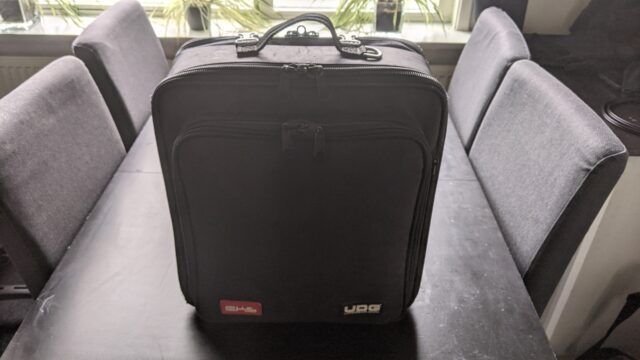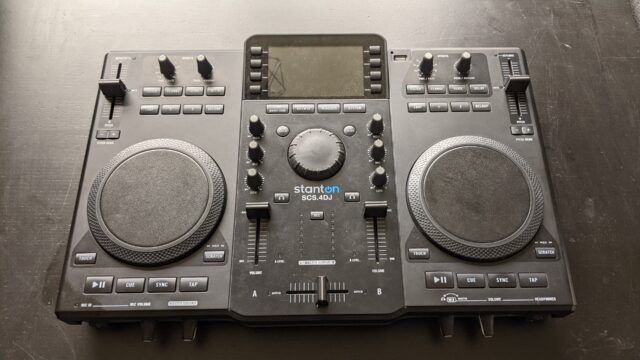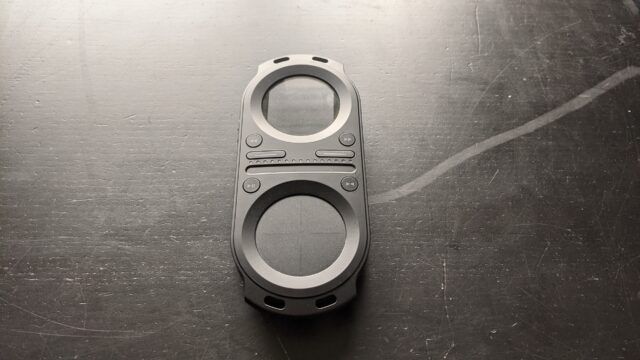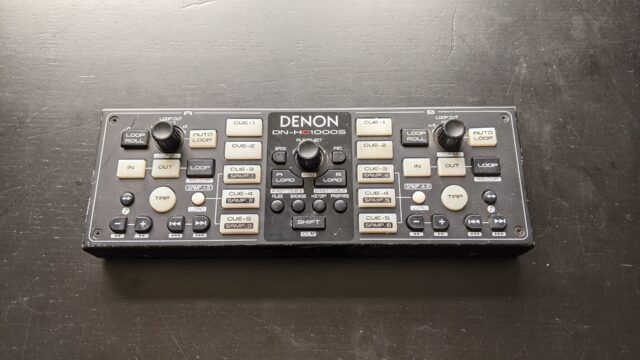It seems that you may have enjoyed my last entry on the weird DJ gear out there, so I am back with a few more items that may have been forgotten through the eons of time. Today, we’ll explore four more items from my collection, created by brands I haven’t previously mentioned – and brands that were quite out there: EKS, Stanton DJ, Tonium, and Denon DJ.
Any of those sound familiar? I don’t doubt that some of these are obscure – but we’ll tip our hats to them today for creating hardware that has made its mark.
EKS: the Otus
EKS was a Finnish company that started way back in 1955. Unfortunately, they went under in 2014 (in similar timing with Vestax, we might add), and not much about them remains online. Their website has gone down, and their social media is dead. However, one relic remains this Facebook page for the EKS Otus, which refers to itself as an “unofficial legacy site” – it’s worth a browse if you’re intrigued.
However, we can provide a few tidbits of background here. EKS was known for their speakers and amplifiers back in the day, as they had two earlier ventures in the DJ controller market with the XP10 and XP5.

Now, here’s a controller that’s quite unlike anything else you’ve seen. In 2008, EKS released this alien-looking device (which, I might add, kind of looks like a Headcrab from Half-Life): the Otus.
Its strange profile has a good reason, though: it was built to be placed on top of a turntable platter, and even has a hole on the bottom where the turntable spindle falls into. It aimed not to take up any valuable space inside the DJ booth, which I find to be a great consideration. I don’t mind if people bring controllers to gigs, but space tends to be limited – and it’s hard to find space for some piano-sized controllers (yes, I’m looking at you, Numark NS7 III). The Otus comes with a nice, somewhat hefty, but not too heavy 7.5″ platter – which feels remarkably good compared to what I expected. The scratch potential on this is remarkably decent.
One of the coolest features I found is that the Otus is a dual-layer controller, with dual stereo RCA out and a headphone jack. This means that you can use it with a mixer as an additional controller replacing 2 media players, or as an all-in-one controller. It has a trackpad with 2 mouse buttons, so you don’t need to use your laptop’s trackpad. This piece of gear was incredibly ahead of its time.
Interesting, DJ Techtools even did a 40 second reveal of the Otus back in 2008 – talk about some old school DJTT content:
Music Radar even goes as far as to refer to the Otus as “The Bruce Lee of DJ controllers” – a major nod to the impression it had on artists who were able to get their hands on it. In 2010, EKS even followed it up with a second edition called the Otus RAW, which featured a physical tempo fader for each deck. The RAW, however, seems to be even harder to find on the used marketplaces around the globe.
Yes, this thing is weird. There’s no doubt that it’s underrated. And when it comes down to it, it’s one of my favorites.
UDG: the EKS Otus bag
To preface: I know that UDG doesn’t make DJ gear. They did make an awesome bag that came with my EKS Otus – one that I felt was worthwhile enough to mention here.
UDG first kicked off in 2000. Back then, DJs were primarily relegated to bulky metal cases to transport their vinyl. UDG decided to change the game and started making much more user-friendly soft cases for vinyl instead.
Since their soft case bags were quite a success, they expanded their line of products and nowadays offer all kinds of carrying equipment – kind of like the Dutch counterpart to Zomo. Now, if only they’d make a controller as awesome as the MC-1000 (side note: hit me up, UDG, and we can design something together).

Instead of arriving in a regular carton box, this controller showed up on my doorstep wrapped in what looked to be a garbage bag. Only after tearing the wrapping open – using my best Hulk Hogan impression – did I find out the seller didn’t ship the Otus in the normal box it originally came in. Instead, they had provided me with this aftermarket UDG bag. It was a surprise, to be sure, but a pleasant one.
The bag has several carrying options: a normal carry handle, a tucked-away sideways carry handle, and the ability to be worn as a backpack with the straps tucked away behind a zipper. It also comes with a nice EKS Otus-labeled microfiber cloth, which is handy since the Otus platter is a bit of a fingerprint magnet. All the main zippers to access gear can be locked with padlocks – which is great – since it also offers a large laptop compartment.
Stanton DJ: the SCS.4DJ
Now, this is a brand that’s arguably been around since, well, forever. Founded back in 1946, Stanton DJ was renowned for its Stanton 500 turntable cartridge. Just about anyone who has ever put a record on a turntable has probably used a Stanton cartridge along the way. They were also instrumental in creating the Final Scratch DVS (Digital Vinyl System) (editor’s note: here’s a great read on the creation of DVS). And, of course, we can’t forget about the Stanton STR8.150 turntable. It was probably one of the best, and certainly heaviest, high-torque DJ turntable ever – clocking in at over ten kilograms.
Stanton DJ now falls under the InMusic umbrella, and it seems to be a bit quiet at the moment. Their last notable product release was the somewhat lackluster ST.150 M2 in 2017.

Before the all-in-one standalone controllers we know today, this crazy device from Stanton: the SCS.4DJ. It was so far ahead from its competitors – years, even. And it would not be until 4 years later that another brand managed to put out a standalone all-in-one unit.
At $500 MSRP, it was an incredible value as well – especially compared to the other offerings on the market at the time. It truly paved the way for the future. It first showed up at Musikmesse 2011 – here’s DJTT’s coverage from back then which mentions Stanton’s upcoming standalone device.
According to a conversation I had with a product manager from Stanton’s team, the company even created an SCS.4DJ MK2 prototype. Unfortunately for us, it never saw the light of day beyond the design team. It was supposedly quite advanced, but alas, we’ll never get to see it in action.
Regardless, that’s not to detract from the awesomeness of the SCS.4DJ. It offers a full color 4.3” screen, 2 regular USB ports, 1 USB B port, an HDD bay with an additional 2 USB ports, onboard FX, balanced output, and a recording option. Even the crossfader has a nice sharp cut. The only real downside is its apparent lack of gain control, which – of course – is an absolute requirement.
The specific unit that I bought was from a nice older lady who used it for their yoga class, but since they had two and were sizing down, they decided to sell this particular one. I let her know that I was in the process of writing articles about DJ gear and that she wasn’t the typical person I normally encounter when buying DJ gear – that was a fun change of pace.
Tonium: the Pacemaker
This is likely the smallest company I’ve written a backstory about – or, at least, compared to the mainstays of the DJ world. Meet Tonium.
It all started back in 2005, during the dawn of the DJ MIDI controller era. A few intrepid Swedes came up with the idea for a handheld DJ device, and thus the Tonium Pacemaker was born. As with a lot of fledgling companies, Tonium went through quite the rollercoaster of highs and lows. Growing a small company of only 4 people, to a staff of 30 in 2008. They eventually ceased production of the Pacemaker in 2011, as Tonium saw the Pacemaker as no longer financially viable.
It’s a shame, honestly. The New York Times, The Guardian, and Wired lauded their product. Today, the Pacemaker can only be found as a music app on iOS – it was relaunched as an app in 2014 – check out DJ Techtools’ first look piece we did here.

This is quite unlike any other piece of gear I have in my collection (save for maybe the Hercules MP3 Mobile and the Numark Orbit), particularly since it is way back from 2007. MIDI controllers weren’t a big thing at this time, and yet – here’s a handheld 128GB standalone device, with a color display from a brand that nobody in the DJ world had heard of before.
With only a fairly few physical controls. The Pacemaker relies on gesture-like actions used on its touchpad, combined with the shift modifier at your thumb that can slide up or down.
The one big drawback is that you still need to have a cable attached to sound output. At that time, the technology to solve the wireless issue wasn’t there yet. But nowadays, it’s still rather difficult or expensive to run a wireless latency-free setup.
Denon DJ: the DN-HC1000S
Who doesn’t know Denon DJ? This may be the oldest brand I’ll write about, as they started way back in 1910 in Japan (surprisingly, though, by an American founder Frederick Whitney Horn). Many seasoned DJs may know Denon DJ from their iconic DN-2000F (and later, the 4000 and 4500) dual CD player from back in 1992. Denon is also one of the most well-known names in the music world today.

The DN-HC1000S feels somewhat like other gear I’ve reviewed, like the Zomo MC-1000. Even the names are vaguely similar, and they are both add-on controllers. This one came first, though; unveiled at NAMM 2010 (see DJTT’s mention of it in coverage here) 3 years before the MC-1000.
This controller was made specifically for Serato DJ Pro to give you transport controls for DVS setups. It’s built like a brick shithouse. You’d expect it to be a lightweight aluminum piece, but it feels like a solid block of steel. The only port on here is a mini-USB. It does not have any fancy soundcards, power cables, or a Kensington lock. It comes with no frills – just the strong, solid quality that is Denon DJ. If I had to pick a weapon from my DJ gear collection in a future zombie apocalypse. This would be it. In more peaceful times, it serves as a great paperweight.
I might have given the DN-HC1000S a bit of a hard time when comparing it to the Zomo MC-1000 as its direct competitor – but it does have its features, and stands as a different device. The Zomo is more of a media player replacement, whereas the DN–HC1000S is an addition to a media player. It’s also worth noting that turntables do not have many advanced functions that digital media players do.
Conclusion: what went right, and what went wrong
These are pieces that did something completely different. They paved a path to a future. And although some succeeded more so than others – especially the Stanton DJ SCS.4DJ rising to the top. But at the end of the day, I see them all as underrated, in their ways.
Now that the DJ gear world is just a handful of brands, it’s great to see a few select pieces of gear still stand from the past. They were made by groups of people that tried something new, which I think is amazing to see – inspiring, even. There is a lot of conformity nowadays when it comes to gear, with stringent expectations of predominantly the same certain brands requested on riders.
That said: with roots in the underground genre of Industrial music myself, I’ve always been open to trying a variety of gear. Perhaps this is not so much as a result of my own choice, but largely because there wasn’t a large variety of good options to choose from. Not every venue can afford all the latest expensive gear – so you have the option of either bringing your own gear, or you play on their stuff which sometimes would fit in the “historic” category.
Maybe the open-mindedness comes from the fact that my background in Industrial music started when artists found Punk music to be too restrained to notes, chords, rhythm, and regular instruments. Pick up a stick and whack an oil drum instead. Shout things through a distorted mic. Take every concept known to music, and just throw it straight out the window.
A final word: every Friday evening, I’m live streaming on Twitch and feature a different controller or device in the first hour. I have quite a backlog of devices I’m working my way through demonstrating, so if you’re interested in exploring more, tune in around 21:00 or 22:00 EU time [CEST] (depending on whether my DJ partner or I start the broadcast) – you might catch something I will write about in the future. I haven’t discussed a few more brands here yet, and I look forward to having a conversation with you about them.
You can check out Nachtraaf on his Twitch, Mixcloud, Facebook, Youtube, and Website for more interesting digs on weird DJ gear.





